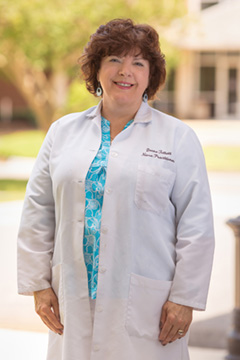
As modern medicine has increasingly made it possible to treat cancer as a chronic disease, the need has arisen for medical professionals specially trained and skilled in caring for survivors. As Donna Talbott, Oncology Survivorship Nurse Practitioner, notes: “There are more than 14 million cancer survivors in America right now, and that number grows every day.”
She adds, “In the early 1960s, when Danny Thomas founded St. Jude’s, 95 percent of all children with leukemia died. Today, 95 percent of children with leukemia live. That has turned around completely in just one generation.” Indeed, it is statistics like those that inspire survivorship nurse practitioners like Talbott every day.
She’s been a nurse for 37 years, having earned her Bachelor’s of Science in Nursing from the University of Akron in 1980. In 2001, she received a Family Nurse Practitioner Master’s Degree from Franciscan University in Steubenville, Ohio. When she began working with oncology patients, she says, she wasn’t convinced she’d enjoy the work, but it was only a short period of time before she knew she was exactly where she belonged: “I felt like I had come home.”
When her family moved from Ohio to Virginia, she took a job working in hospice care until a position in oncology became available. That opportunity came when she saw a Bon Secours ad for ‘Oncology Survivorship Nurse Practitioner.’ She applied and was hired, happy to be back with oncology patients. “It was a challenge,” she says, “because at the time, they didn’t really have a formal survivorship program in place. So we were tasked with developing it.”
Using guidelines and requirements established by the Commission on Cancer, Talbott and her team set to work, and today, all Bon Secours cancer survivorship programs in Hampton Roads are fully accredited.
Much of the work Talbott does on a daily basis involves developing individualized survivorship care plans for patients who have completed their cancer treatment. These plans are comprehensive, and include a list of each physician who has treated the patient for any aspect of cancer care. “The second part of the plan is the patient’s cancer story,” Talbott says, “including when they were diagnosed, what kind of cancer they have, what their pathology report showed, what treatment they had and when.”
The third part of the plan describes follow-up care – what and when. “This is an extremely critical element,” Talbott says, “because some studies show that some cancer survivors fail to follow up regularly. It can be for lack of transportation, not knowing who should be scheduling follow-ups, or simply lack of communication among members of the team. I help them understand how important it is.”
The plan also helps patients understand side effects, and addresses emotional, physical and financial problems they may be having. Finally, the plans emphasize wellness, especially changes these patients can make to reduce the risk of cancer in the future.
Donna Talbott is passionate about caring for cancer patients, but even more passionate about teaching patients how to reduce the risk of cancer: “When people tell me they’ve never had a colonoscopy or a mammogram or a PSA test, I get upset. Some of these diseases – like colon cancer – are almost 100 percent preventable. We have grants to educate people, like the 80% by 2018 colon cancer screening. I cannot say it often enough: get screened. And if your doctor doesn’t talk to you about it, bring it up yourself!”

